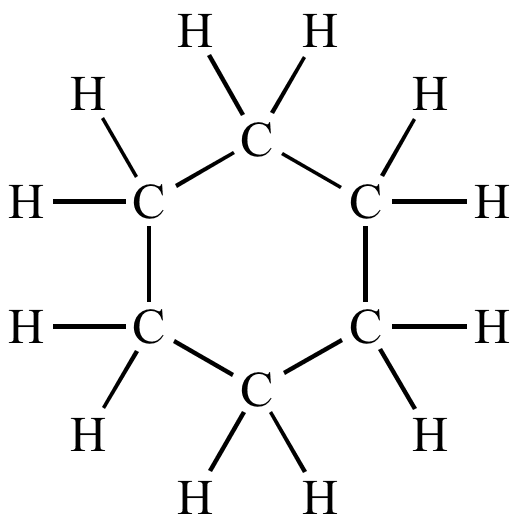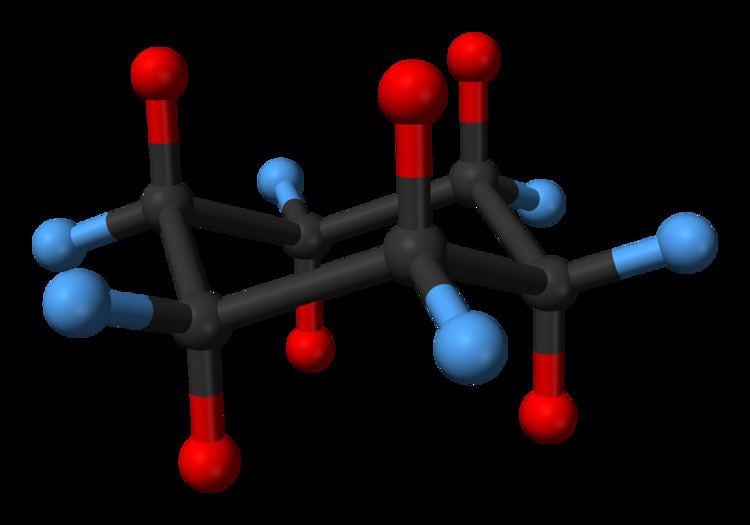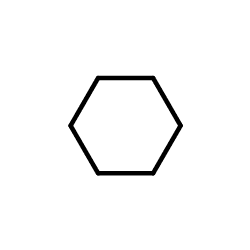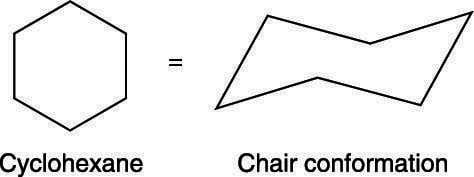Appearance Colorless liquid Formula C6H12 Density 779 kg/m³ | Related compounds Boiling point 80.74 °C Molar mass 84.16 g/mol | |
 | ||
Thermodynamicdata Phase behavioursolid–liquid–gas | ||
Chair and boat shapes for cyclohexane organic chemistry khan academy
Cyclohexane is a cycloalkane with the molecular formula C6H12 (abbreviated to Cy). Cyclohexane is mainly used for the industrial production of adipic acid and caprolactam, which are precursors to nylon. Cyclohexane is a colourless, flammable liquid with a distinctive detergent-like odor, reminiscent of cleaning products (in which it is sometimes used).
Contents
- Chair and boat shapes for cyclohexane organic chemistry khan academy
- Conformations of cyclohexane organic chemistry khan academy
- Modern production
- Historical methods
- Early failures
- Success
- Reactions
- Uses
- Laboratory uses
- Conformation
- Solid phases
- References

Conformations of cyclohexane organic chemistry khan academy
Modern production

On an industrial scale, cyclohexane is produced by hydrogenation of benzene. Producers of cyclohexane accounts for approximately 11.4% of global demand for benzene. The reaction is highly exothermic, with ΔH(500 K) = 216.37 kJ/mol). Dehydrogenation commenced noticeably above 300 °C, reflecting the favorable entropy for dehydrogenation.
Historical methods

Unlike benzene, cyclohexane is not easily obtained from natural resources such as coal. For this reason, early investigators synthesized their cyclohexane samples.
Early failures


Surprisingly their cyclohexanes boiled higher by 10°C than either hexahydrobenzene or hexanaphtene but this riddle was solved in 1895 by Markovnikov, N.M. Kishner, and Nikolay Zelinsky when they reassigned "hexahydrobenzene" and "hexanaphtene" as methylcyclopentane, the result of an unexpected rearrangement reaction.
Success
In 1894 Baeyer synthesized cyclohexane starting with a Dieckmann condensation of pimelic acid followed by multiple reductions:

In the same year E. Haworth and W.H. Perkin Jr. (1860–1929) prepared it via a Wurtz reaction of 1,6-dibromohexane.
Reactions
Cyclohexane is rather unreactive, being a non-polar, hydrophobic hydrocarbon. It reacts with superacids, such as HF + SbF5, which will lead to cracking. Substituted cyclohexanes, however, may be reactive under a variety of conditions, many of which are important in organic chemistry.
Uses
Commercially most of cyclohexane produced is converted into cyclohexanone–cyclohexanol mixture (or "KA oil") by catalytic oxidation. KA oil is then used as a raw material for adipic acid and caprolactam.
It is used as a solvent in some brands of correction fluid and as a reactant in vacuum carburizing furnaces which are used in metal heat treating by equipment manufacturers.
Laboratory uses
Cyclohexane is sometimes used as an organic solvent.
Cyclohexane is also used for calibration of differential scanning calorimetry (DSC) instruments, because of a convenient crystal-crystal transition at −87.1 °C.
Cyclohexane vapour is used in vacuum carburizing furnaces, in heat treating equipment manufacture.
Conformation
The 6-vertex edge ring does not conform to the shape of a perfect hexagon. The conformation of a flat 2D planar hexagon has considerable angle strain because its bonds are not 109.5 degrees; the torsional strain would also be considerable because all of the bonds would be eclipsed bonds. Therefore, to reduce torsional strain, cyclohexane adopts a three-dimensional structure known as the chair conformation. There are also two other intermediate conformers; half chair, which is the most unstable conformer, and twist boat, which is more stable than the boat conformer. This was first proposed as early as 1890 by Hermann Sachse, but only gained widespread acceptance much later. The new conformation puts the carbons at an angle of 109.5°. Half of the hydrogens are in the plane of the ring (equatorial) while the other half are perpendicular to the plane (axial). This conformation allows for the most stable structure of cyclohexane. Another conformation of cyclohexane exists, known as boat conformation, but it interconverts to the slightly more stable chair formation. If cyclohexane is mono-substituted with a large substituent, then the substituent will most likely be found attached in an equatorial position, as this is the slightly more stable conformation.
Cyclohexane has the lowest angle and torsional strain of all the cycloalkanes, as a result cyclohexane has been deemed a 0 in total ring strain.
Solid phases
Cyclohexane has two crystalline phases. The high-temperature phase I, stable between 186 K and the melting point 280 K, is a plastic crystal, which means the molecules retain some rotational degree of freedom. The low-temperature (below 186 K) phase II is ordered. Two other low-temperature (metastable) phases III and IV have been obtained by application of moderate pressures above 30 MPa, where phase IV appears exclusively in deuterated cyclohexane (note that application of pressure increases the values of all transition temperatures).
Here Z is the number structure units per unit cell; the unit cell constants a, b and c were measured at the given temperature T and pressure P.
